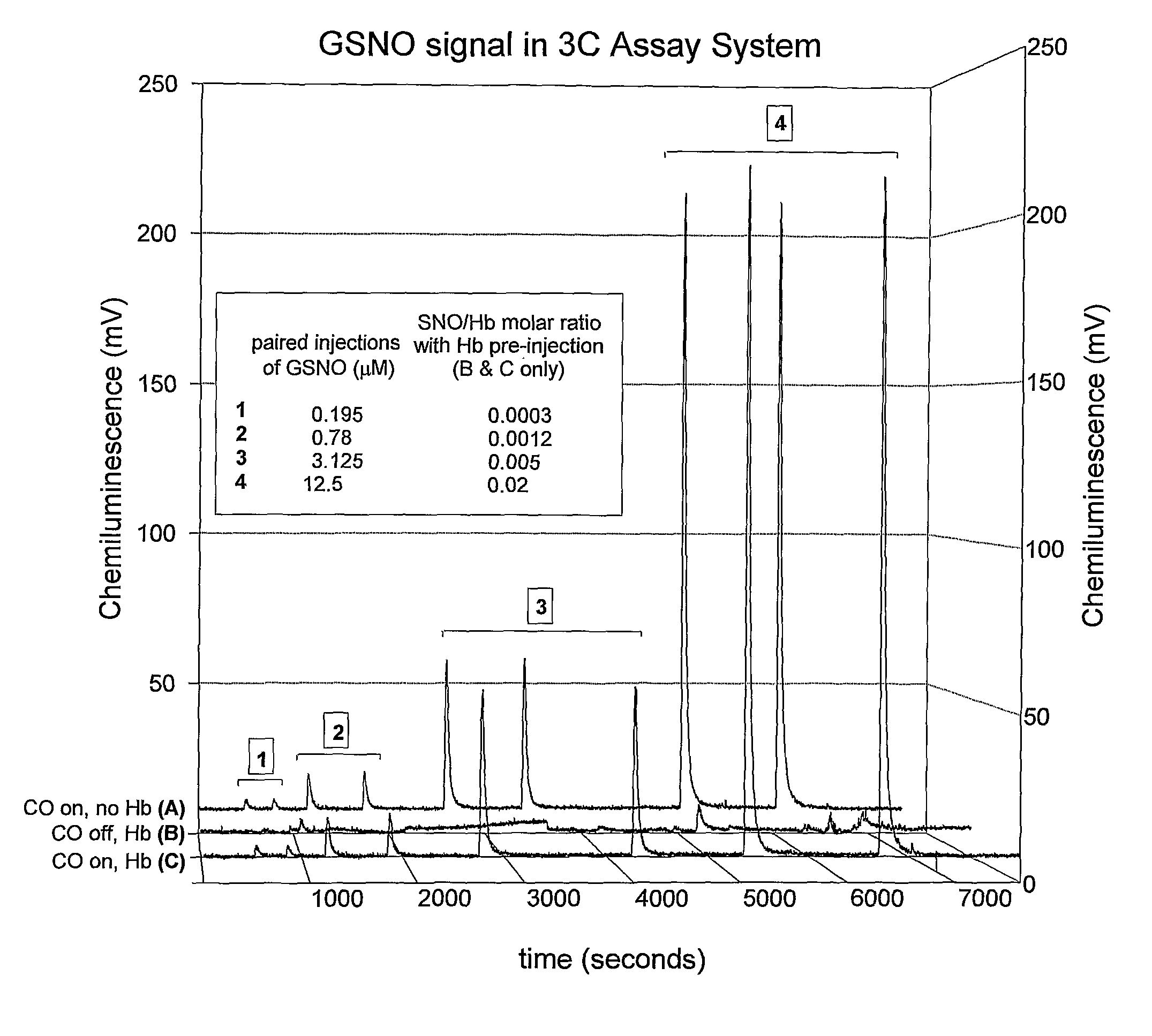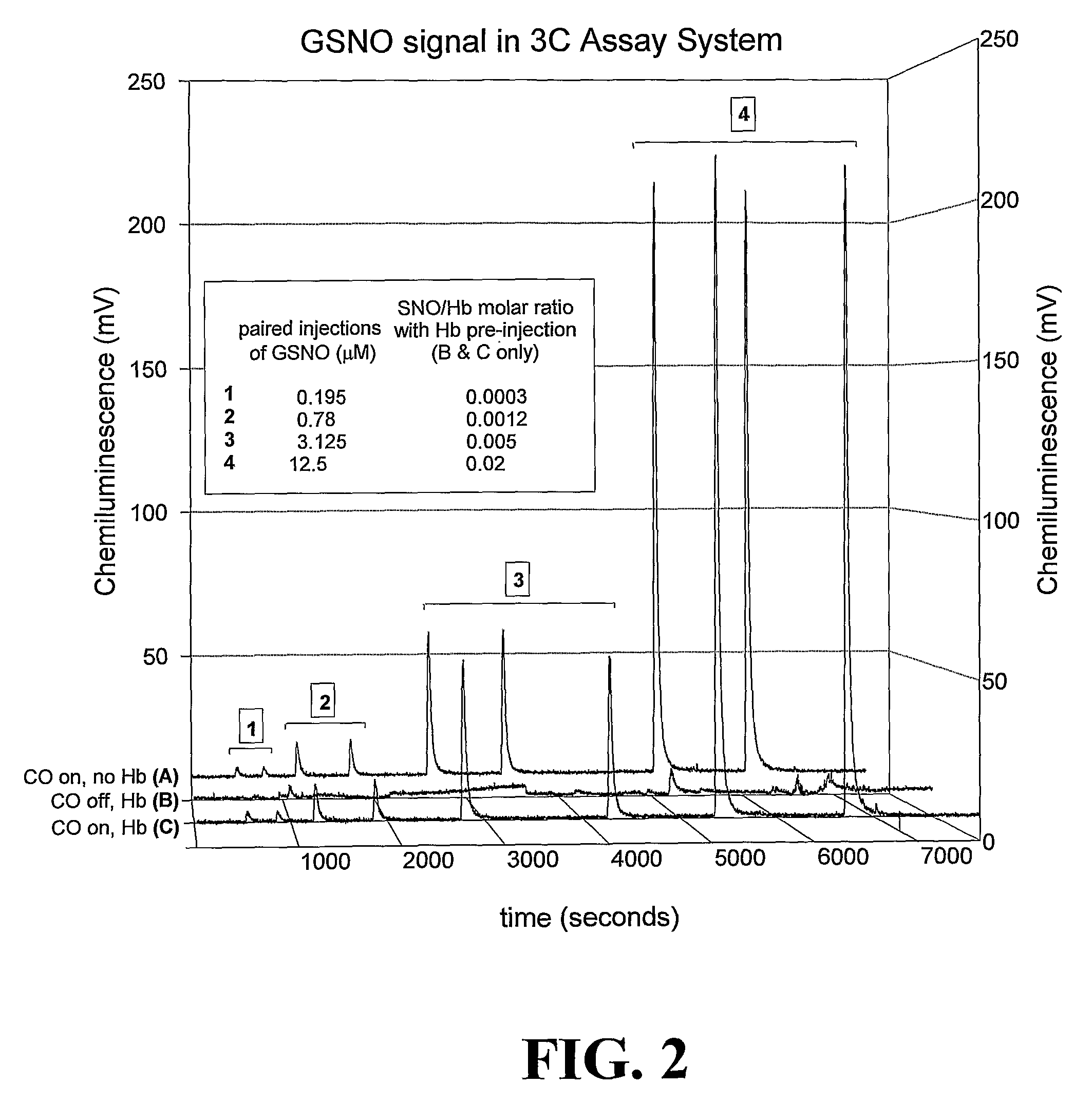Methods for identifying and measuring S-nitrosothiol bonds in heme-containing cells and molecules
a technology of s-nitrosothiol and heme, which is applied in the field of methods for identifying and measuring s-nitrosothiol bonds in heme-containing cells and molecules, can solve the problems of lack of reliable assays, hampered sno signaling studies, and complex assays requiring extensive hemoglobin
- Summary
- Abstract
- Description
- Claims
- Application Information
AI Technical Summary
Benefits of technology
Problems solved by technology
Method used
Image
Examples
example 1
Assay for SNO-Hemoglobin Ex Vivo
[0107]Methods
[0108]Protocol: Copper Cysteine Assay for S-Nitrosothiols
[0109]1. Prepare fresh copper cysteine (Cu / cys) solution comprising 1 μM CuCl, 1 mM cysteine (4.9 mg copper (1+) chloride (Sigma #C3294, stored at room temperature (“RT”), bring to 500 ml with distilled H2O, add 60.5 mg cysteine (Sigma #C7755, stored at −20° C. or 87.6 mg Sigma #C6852); adjust pH to 6.6 with 0.1N NaOH; store at room temperature; the solution should be prepared fresh daily).
[0110]2. Adjust water bath to 50° C. and cold water flow to the condenser.
[0111]3. Wash purge vessel with acetic acid, then with H2O, finally with the Cu / cys solution.
[0112]4. Fill the reaction chamber with 3-5 ml of Cu / cys solution and adjust system. Data not shown demonstrate that a larger reflux chamber holding 10-15 mL of Cu cysteine and accommodating up to 1 mL of sample injection improves the ratio of signal-to-noise in the NO readout.[0113]a. Close lid to chamber.[0114]b. Close stopcock fro...
example 2
SNO-Proteins in Erythrocytes (RBC's)
[0132]Here, the Cu / cysteine / CO assay was used in precisely the method described in Example 1. However, instead of isolating Hb from erythrocytes, intact erythrocytes were injected into the assay chamber after washing in physiological buffer at the precise pH and pCO2 at which the circulating erythrocytes had been drawn from the artery, vein, or capillary (See Table 1 and FIG. 3). Specific data ranges for red blood cell S-nitrosothiol content (SNORBC) are provided in Table 1. All other standards and controls apply.
[0133]This assay requires even less pre-assay manipulation than the SNO-Hb assay, and therefore provides an even more accurate picture of SNO-RBC content under specific conditions relevant in vivo. A potential disadvantage is that it measures all other erythrocytic SNO's, such as S-nitroso-anion exchange protein 1 and GSNO itself in RBC's, and therefore is not specific for SNO-Hb. However, this information (total RBC SNO content) may be o...
PUM
| Property | Measurement | Unit |
|---|---|---|
| temperature | aaaaa | aaaaa |
| temperature | aaaaa | aaaaa |
| temperatures | aaaaa | aaaaa |
Abstract
Description
Claims
Application Information
 Login to View More
Login to View More - R&D
- Intellectual Property
- Life Sciences
- Materials
- Tech Scout
- Unparalleled Data Quality
- Higher Quality Content
- 60% Fewer Hallucinations
Browse by: Latest US Patents, China's latest patents, Technical Efficacy Thesaurus, Application Domain, Technology Topic, Popular Technical Reports.
© 2025 PatSnap. All rights reserved.Legal|Privacy policy|Modern Slavery Act Transparency Statement|Sitemap|About US| Contact US: help@patsnap.com



